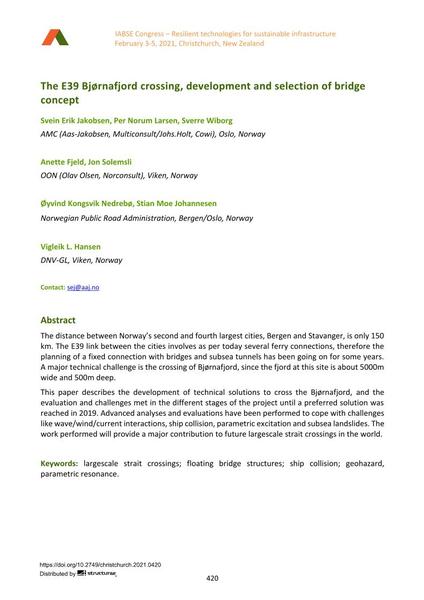The E39 Bjørnafjord crossing, development and selection of bridge concept

|
|
|||||||||||
Détails bibliographiques
| Auteur(s): |
Svein Erik Jakobsen
(AMC (Aas-Jakobsen, Multiconsult/Johs.Holt, Cowi), Oslo, Norway)
Per Norum Larsen (AMC (Aas-Jakobsen, Multiconsult/Johs.Holt, Cowi), Oslo, Norway) Sverre Wiborg (AMC (Aas-Jakobsen, Multiconsult/Johs.Holt, Cowi), Oslo, Norway) Anette Fjeld (OON (Olav Olsen, Norconsult), Viken, Norway) Jon Solemsli (OON (Olav Olsen, Norconsult), Viken, Norway) Øyvind Nedrebø (Norwegian Public Road Administration, Bergen/Oslo, Norway) Stian Moe Johannesen (Norwegian Public Road Administration, Bergen/Oslo, Norway) Vigleik L. Hansen (DNV-GL, Viken, Norway) |
||||
|---|---|---|---|---|---|
| Médium: | papier de conférence | ||||
| Langue(s): | anglais | ||||
| Conférence: | IABSE Congress: Resilient technologies for sustainable infrastructure, Christchurch, New Zealand, 3-5 February 2021 | ||||
| Publié dans: | IABSE Congress Christchurch 2020 | ||||
|
|||||
| Page(s): | 420-427 | ||||
| Nombre total de pages (du PDF): | 8 | ||||
| DOI: | 10.2749/christchurch.2021.0420 | ||||
| Abstrait: |
The distance between Norway’s second and fourth largest cities, Bergen and Stavanger, is only 150 km. The E39 link between the cities involves as per today several ferry connections, therefore the planning of a fixed connection with bridges and subsea tunnels has been going on for some years. A major technical challenge is the crossing of Bjørnafjord, since the fjord at this site is about 5000m wide and 500m deep. This paper describes the development of technical solutions to cross the Bjørnafjord, and the evaluation and challenges met in the different stages of the project until a preferred solution was reached in 2019. Advanced analyses and evaluations have been performed to cope with challenges like wave/wind/current interactions, ship collision, parametric excitation and subsea landslides. The work performed will provide a major contribution to future largescale strait crossings in the world. |
||||
